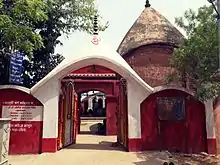Bamakhepa
Bamakhyapa (Bengali: বামাখ্যাপা, romanized: Bamakhæpa, lit. 'mad saint'; 1837–1911[1]), born Bamacharan Chattopadhyay, was an Indian Hindu saint who is held in great reverence in Tarapith and whose shrine is also located in the vicinity of the Tara temple in Birbhum. He worshipped Maa Tara as if she was his own mother. He was born at Atla village in the Rampurhat subdivision of the Birbhum district.[2]

Bamakhepa | |
|---|---|
 Bamakhepa | |
| Personal | |
| Born | Bamacharan Chattopadhyay 22 February 1837 |
| Died | July 18, 1911 (aged 74) |
| Cause of death | Natural |
| Religion | Hinduism |
| Nationality | Indian |
| Temple | Tarapith |
| Philosophy | |
| Religious career | |
| Guru | Swami Kailashpati and Vedagya Mokshadananda |
Disciples | |
| Honors | Tarapith Bhairav |
Worship
_idol_at_the_Tarapith_temple_complex.jpg.webp)
Bamakhaypa, goddess Tara's ardent devotee lived near the temple and meditated in the cremation grounds.[1] He was a contemporary of famous Bengali saints like Ramakrishna Paramhamsa and Vishuddhanand Paramhamsa from Gyanganj or Siddhashram who established Navmundi Asan at Kashi. At a young age, he left his house and came under the tutelage of a Siddha tantric saint named Kailashpati and a vedic saint named Swami Mokkshadananda, who lived in a village name Dakshingram, in Birbhum district. Later he relocated to maluti, an old temple village on the banks of Dwarka River. He stayed in Mouliksha temple for continuing the worship of Holy Mother.[3]

He perfected yoga and Tantric sadhana (worship) under the tutelage of his guru baba Kailashpati, and after years of Tantra sadhana and akhanda brahmacharya he was able to Develop his sushumna naadi and activate the 7 Chakras of his body, additionally Bamakhyapa also did the "shav sadhana" which is also considered as the last stage of tantra sadhana before deity appears before the sadhaka. Bamakhyapa was one of those rare and extraordinary saints who successfully completed the shav sadhana that too on the auspicious night of "kaushiki amavasya". His sadhana was successful at the end and it is said that Maa tara herself appeared before him and gave him "Brahmagyan"(knowledge of self realization) additionally goddess also gave him the 8 siddhis so that he can now continue his sadhana on the "panchamundi asana" (previously used by brahmarishi Vasistha) of Tarapith .His siddhi on "Tara sadhana" also resulted in his becoming the spiritual head of Tarapith. People came to him seeking blessings or cures for their illness, in distress or just to meet him. He did not follow the set rules of the temple and as result was even once roughed up by the temple priests for taking food meant as offering for the deity. It is said: Ma Tara appeared in the dream of Maharani ("Queen") of Natore- Rani Annadasundari Devi and told her to feed the saint first as he was her son. After this incident, Bamakhaypa was fed first in the temple before the deity and nobody obstructed him.[4] It is believed that Ma Tara gave a vision to Bamakhaypa in the cremation grounds in her ferocious form and then took him to her breast.[1] He is also considered one of the main spiritual figures of Bengal Renaissance for his unbound devotion for Ma Tara.
Popular culture
Beginning in 2007, a teleserial named 'Sadhak Bamakhepa' about Bamakhepa ran on television in Bengal. By late 2011, it had run for 1500 episodes.[5]
In the teleserial Mahapeeth Tarapeeth, the life of the ardent devotee Bamakhepa was also depicted elaborately.[6]
References
- Kinsely, p. 111
- Harding, Elizabeth U. (September 1993). Kali: The Black Goddess of Dakshineswar. ISBN 9780892546008.
- "Break-in at heritage temple". www.telegraphindia.com. The Telegraph. 7 December 2013.
- Harding, Elizabeth U. (1998). Kali: the black goddess of Dakshineswar. Motilal Banarsidass Publ. pp. 275–279. ISBN 81-208-1450-9. Retrieved 26 June 2010.
- Gomolo news desk. (29 Nov 2011). "Sadhok Bamakhyapa becomes highly popular" Archived 4 October 2018 at the Wayback Machine (accessed 31 Jan 2013)
- "আসছে নতুন ধারাবাহিক 'মহাপীঠ তারাপীঠ'". www.anandabazar.com (in Bengali). Anandabazar Patrika. 27 January 2022.
Further reading
- Dalrymple, William (2009). Nine Lives. pp. 203–233. ISBN 978-1-4088-0153-6. Retrieved 19 June 2010.
{{cite book}}:|work=ignored (help) - Kinsley, David R. (1997). Tantric visions of the divine feminine: the ten mahāvidyās. University of California Press. ISBN 978-0-520-20499-7.
- Ramos, Imma (2017). Ramos, Imma (ed.). "The Myth of the Goddess Sati". Pilgrimage and Politics in Colonial Bengal. Routledge. 1: 138. doi:10.4324/9781315223148. ISBN 978-1-315-22314-8.